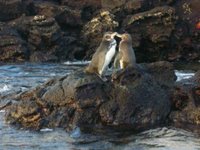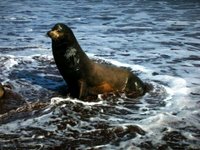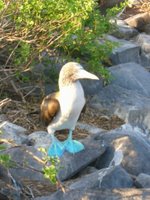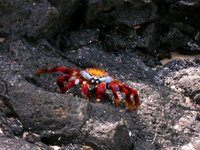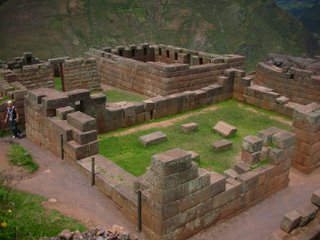Sunday, August 20, 2006
Saturday, May 06, 2006
The Last Day

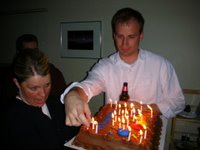
Perhaps because I had spent so little time exploring the main land, Ecuador was surprisingly easy to leave. As we got closer to Miami, my sense of wistfulness increased. I finished my copy of The Motorcycle Diaries minutes before we landed in Miami. I started a conversation with my spanish-speaking neighbor, knowing that this may be the last opportunity I had to practice the language for awhile.
From the air, it was easy to see the perfect rows of nearly identical houses surrounded by groomed yards, complete sidewalks, and paved streets. During my trip, a man had told me he loved America because "It was perfect." At the time, I thought it was an odd comment. I still don't know if he was being sincere or sarcastic, but from this viewpoint I knew what he had meant.
After landing, it was strange how quickly I reverted to my role as the entitled American. When it took forever for our luggage to arrive, rather that waiting patiently, knowing that it would come eventually, I went to customer service demanding to know what was taking so long. In the security line, rather than waiting for my turn, knowing that the plane wouldn't leave without me, I told the guard I had a tight connection and was ushered to the front of the line.
My impatience only grew when we got to Dallas. There was a storm and all of the departing flights had been delayed. I couldn't afford a delay! I had been planning, since before I left on this trip, a surprise party for Rod. This day, a Friday, was two days before his birthday and three days before he thought I would be home. I had planned on arriving in Salt Lake at 8:15, Nici would be picking up a cake and then picking me up at the airport, people were showing up at my house at 8:30 (Jess, who I had given a spare key before the trip, and Carrie, would be there to let them in), and Rory was supposed to bring Rod back to the house at nine. The flight from Dallas to SLC was the longest of my life!
In the end, everything worked out perfectly. Though my flight was delayed an hour and the airline lost my luggage, I still managed to get home before Rod. We had turned out all the lights, but forgotten to shut the front door. We could hear Rod outside, concerned that he was being robbed. When he flipped on the lights, the shocked look on his face was priceless! He hadn't suspected a thing. =) It was a great night!
Day 93: Quito, Ecuador

I wish I could say that my last full day in South America was filled with excitement. It wasn't. In fact, I didn't even go to see the sights that Quito offered. Instead I spent the day running errands to prepare for my trip home. In the morning, while my friend Jenn (from the Galapagos trip) was busy at her volunteer project, I decided I was in dire need of a pedicure. My feet had been horribly mistreated in the last three months. While I was at the salon, I decided an eyebrow wax wouldn't be a bad idea either (in my neverending quest to keep the weight of my pack down, I had left tweezers at home). Unfortunately, the spanish words for wax and dye are very similar. The aesthetician had used the lightest color she had, but because the salons in Ecuador deal mainly with dark-haired people, I ended up with eyebrows about five shades darker than my sun-bleached hair. I left looking like Groucho Marx.
For lunch, I treated Jenn to a typical Ecuadorian meal. I knew it would be my last three-course meal for $3. Then we met up with our friend Esteban (one of the guides we met while staying in the Galapagos) and his cousins. They took us to an indigenous market, where I hurriedly tried to buy souvenirs for friends and family.
My last night in South America was not a wild and crazy blowout, but instead a relaxing dinner of wine, cheese, fresh bread, and fresh fruit, followed by an attempt to watch our bootlegged copy of Syriana.
Thursday, May 04, 2006
Day 90-91: Tayrona National Park


This place had been described to us as paradise on Earth. Regina and I were in no position to disagree. We rented two hammocks on the beach and spent the afternoon exploring the beaches that lined the Carribean Coast of Colombia. With the turquoise water, white sandy beaches, and bag of sugar mangos (which we consumed in a day), we were two happy campers.
The next morning we swam and soaked up sun on our beach, Cabo San Juan. Then, to break up the three hour hike back to the road, we stopped and swam at each beach we passed on the way back to the road except for Arrecifes, which is known for its deadly undertow. At the last swimmable beach, known as La Piscina or the "Pool", we were woken from our post-swim nap by a loud thud. A man had climbed a nearby palm tree and was throwing down coconuts. After climbing down, he hacked at the coconuts with his machete and offered them to us and a nearby family for drinking and eating. Mmmm . . . .
As this was my last night in Colombia, Regina and I celebrated by going to our favority juice guy and buying another bag of sugar mangos. Colombia has the most amazing fruit! There are fruit stands everywhere and they are filled with fruits I have never seen before. Sugar mangos, my favorite new fruit, are small peelable mangos that are so sweet and juicy. Compared to these sugar mangos (or even Colombia's regular mangos), the mangos we have in the United States taste like mango flavored popsicle sticks. Then there are carts with baskets of fruits and blenders about every four feet. For between $.25 and $1.50 you can get a huge fruit shake. My favorite flavor was tomate de arbol (tomato of the tree), moracuno (passion fruit), lulo (no translation (maybe lychee), but a small fruit the size of a grape that has a hard green shell with soft white flesh and a pit the size of a plum pit), and a squeeze of limon (lime). By the time I left Colombia, Regina and I had consumed four of those and half a bag of sugar mangos. I am sure going to miss the fruit . . . and Regina.
Day 88-89 - Ciudad Perdida


The Lost City is accessed by a 40 km hike and 1200 steps. It is made up of 169 circular terraces, where straw huts once stood, and series of paths connecting them. It is believed to be the largest and most sacred city of the Tayrona people, who abandoned the city during the Spanish conquests. Unlike most of the indigenous cultures, the Tayronans living at the Ciudad Perdida were not conquered by the Spanish. In fact, the city wasn't "discovered" until 1972 when treasure looters stumbled upon it.
Now it only has a few inhabitants, Kogi ancestors of the Tayrona people. According to the online encyclopedia, it is in an area that "is currently in the geographic center of a war between the Colombian army, right-wing paramilitary groups (AUC) and left-wing guerilla groups like Ejército de Liberación Nacional (ELN) and Revolutionary Armed Forces of Colombia (FARC). On September 15, 2003, ELN kidnapped 8 foreign tourists that were visiting Ciudad Perdida, demanding government investigation of human rights abuses in exchange for their hostages. ELN released the last of the hostages three months later. The AUC has declared itself protector of this area." I'm glad I read that after the hike. =)
Day 86: A recipe for Coke


Included in the hike to the Ciudad Perdida was a tour of a cocaine factory. I envisioned a large warehouse in the middle of the jungle with piles of white powder and a small army of men with automatic weapons. What I got was a small hut in the middle of the jungle operated by an elderly man, who was more than happy to walk us through each step of the process.
Cocaine
1 kilo coca leaves yeilds 1 gram of cocaine
Ingredients: 1 kilo coca leaves, 1/2 kilo salt, 1/2 kilo white paint, 180 liters of gasoline, 8 liters of water, 8 Tbsp. sulphuric acid, pergamonato (iodine like anesthetic), and caustic soda (some sort of acid).
Directions: Grind coca leaves with lawn trimmer. Use dirty boots to mix/stomp in salt and paint. Let set over night. Put in barrel with gasoline. Let set for five hours. Add water and sulphuric acid. Mix with big plunger (can be made by attaching punctured bucket lid to broomstick). Siphon out excess liquid. Add pergamonato. Put mixture on a strainer to filter remaining liquid into a bucket. Add caustic soda to this liquid cocaine. Strain again. Dry in sun with 20 armed guards. Cocaine is ready for smoking.
Variation: If you prefer to snort your cocaine, mix 1 tbsp. of acetone (nail polish remover) per glass of liquid before drying.
At the end of the tour, the owner offered us samples. Uh . . . no gracias!
Day 85 - 89 Hiking to the Ciudad Perdida


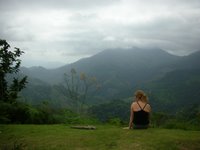

My traveling philosophy has always been "what doesn't kill me, will make a great story to write home about." That was certainly true of the Ciudad Perdida hike. My first sign should have been when our "two-hour jeep ride" turned into a four-hour jeep ride because (1) our jeep stalled four times on our way to the mountain where the trailhead was located, (2) once we began climbing the mountain, the jeep stalled and wouldn't re-start (despite our efforts to push it uphill!), (3) the twelve of us (two groups of five and the guides) and our gear were squished into the back of the only truck that was nice enough to give us a lift, smashing our bread and breaking our eggs in the process, and (4) our replacement truck got a flat tire ten minutes after it picked us up.
The trip did not improve after we (finally) started the hike. Though it is to a Lost City, the hike is fairly straightforward. It is by no means easy, though. I wasn't scared of being captured by guerrillas (at least not until our guide started telling us stories about how many times that had happened), I was sure that the humidity would kill me first. Within the first hour, my clothes were completely drenched with sweat. It was going to be fun wearing these clothes for the next six days! By the end of the hike, I was "falling" into the river because hiking in dripping wet clothes was slightly more comfortable than hiking in sweat-drenched clothing.
On the third and fourth day, we had to cross the river eight times within an hour. The company had told us to bring sandals "for relaxing," but had failed to mention that we might need them for crossing rivers. As I was carrying my own gear, I had left my Chacos safely in my pack back at the hostel. Rather than take my shoes on and off at each river crossing, it was easier (and faster) just to go barefoot. Regina, who was already hiking in her Chacos, graciously offered to carry my shoes so I could concentrate on not (a) cutting my foot, (b) spraining my ankle, (c) falling in the river, (d) stubbing my toes, or (e) (I didn't realize this was a risk until I smooshed one) stepping on the big camouflaged spiders. When we reached the last river crossing, my feet were raw and I was so excited to be done. But, alas, Regina fell in the river. I spent the rest of the day hiking in one wet shoe.
At night, the mosquitoes moved in and they were ravenous. Just when I thought that every inch of exposed skin had been bitten, I would find a new bite in a random place like my ear lobe. My legs looked diseased! We would go to bed early to escape the mosquitoes, but it was hard to get a decent night's sleep in the hammocks.
To top all of this off, our guide was lousy. The company, Turcol, doesn't buy the food or train the guides, but instead gives the guides money to buy food and expects them to educate themselves. As a result, the guides have an incentive to buy less food (more money for them) and to make up stories about the lost city rather than learning about it. Now, if you have a self-motivated guide, this is not a problem. The group that was hiking with us had a fabulous guide. We were not so lucky. Our guide did not buy enough food. Bread and cheese are not a sufficient breakfast for a five-hour hike! My group was saved from starving (okay I'm being a little dramatic, but I really was famished) only because Elizer, the other guide, and the kind boys from the other group, who had brought enough food to satisfy their munchies, were kind enough to share with us. Also, when we were really desperate, we would ask our cook, Ali, if there was pineapple. He would say no, then run down the path carrying a big machete. Minutes later, he would return with very fresh pineapple. Mmmm.
When we did reach the Ciudad Perdida, our guide told us all about the city. Lies, lies, lies! When we asked Elizer about some of the things our guide had told us, he just laughed and then, when he was able to compose himself, told us what really had happened. For example, our guide told us that the Tayrona people died because they didn't have enough salt or fish and those that survived the food shortage killed themselves because it was better to die than become a slave. Eli informed us that the Tayrona people died because when the Spanish conquistadors arrived there was a war in Pueblito. Some of the Lost City's warriors went down to help the people of Pueblito fight and when they returned they brought clothing that contained diseases. Also, our guide told us that it took hundreds of years to build the Lost City. As impressive as the Lost City was, it seemed odd that it took hundreds of years to build these stone terraces when the temples of Machu Picchu were built in only 90 years. When we asked our guide about it, he snapped that he was not a guide for Machu Picchu and did not know why it had been built so quickly. Eli later told us that the Lost City had been built in 80 years.
Another great example of our wonderful guide is, on the hike back, Regina was about to climb over a log that had fallen over the path. I noticed that there was a very large scary looking snake draped over it. After a couple of minutes of deciding what to do, we realized that someone had already chopped the head off of the snake. When we caught up to the guide, we asked him about the snake. He hadn't noticed it! When I showed him the picture I had taken, he told us it was a very dangerous snake with mortal venom. How reassuring! Our guide, the person who was supposed to keep us safe, had somehow missed the large and deadly snake lying in the middle of the path.
Now that I'm done ranting . . . the hike was not so bad. Once I learned to ignore our guide and how disgusting I felt, it was really beautiful. The hike to the Lost City takes three days up and three days back. We climb three passes and over 1,000 stairs to get to it. The trail leads us through really beautiful pristine jungle. Every day there was a beautiful pool to swim in when we finished with our hike. There were at least three zen moments that made the hike worth it. The first was sitting at the top of our first big climb and looking over the valley. There was nothing but jungle and mist. It was incredible!
The second was after our second day of hiking. We were hot and sweaty and more or less ran to the river as soon as we made it to camp. The water was cold and the current was too strong for swimming under the waterfall. I headed for the large flat boulder in the middle of the river instead. I was sunning on it when it started to rain. The sun was still shining and the rain was warm. I stayed there until our guide called us for dinner.
Then, after the fifth day hiking, Regina and I headed down to the river. A little boy who lived near our camp came down to tell us that there was a much better swimming spot nearby. We followed him to this amazing waterfall. There was no way to make it down the pool it created without jumping off of a cliff. I was the first one in. The two of us had the waterfall all to ourselves. We laughed that to us this was paradise, but to the little boy who had lead us here, it was home.
My favorite part of the hike, though, was the solitude. I purposely distanced myself from the group. I had a lot of time to think and to come to terms with the fact that my trip, and with it my transitory lifestyle, would be ending in a few short days. After this trip ends, I will no longer be doing things for the next semester, month, or year. Instead my obligations will be for a more indefinite period of time. I will have to become the dreaded "settled" or, worse, "grown-up." As much as I had resisted that moment, I found myself looking forward to the next chapter. In the end, I felt like I had conquered much more than a six-day, sweaty hike to a found city.
Tuesday, April 18, 2006
Day 84: Santa Marta

Now, I'll be the first to admit that after scubadiving in the Galapagos, I thought diving in other places would be a let down. I decided to go in Santa Marta only because I needed more experience and because it was super cheap. I was pleasantly surprised at how much I enjoyed it.
Santa Marta and the surrounding areas has an amazing coral reef. True, there were no sharks, rays, turtles, or sea lions, but the coral itself was incredible. Instead of spending the dive looking for "big fish," I spent the time taking in everything. You didn't have to look very far or hard to find something beautiful. The coral was colorful and covered with little flowers that sucked themselves in as we swam past. The ocean flora was swaying in the tide. The variety of fish was outstanding. There were fish that had day-glo blue stripes, the largest angel fish I have ever seen, and every color of trumpet fish imaginable. The dive was not without its "big fish" either. We saw barracuda, three different colors of moray eels, and a worm that was the length and width of my arm.
Monday, April 17, 2006
Day 82: Cartagena, Colombia

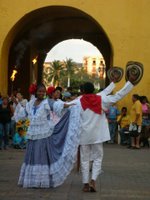
I arrived in Cartagena just in time for the Semana Santa celebration. The plazas and parks were packed with people dancing traditional dances. I bought some dulces (sweets) at the Portal del Dulces in the Plaza de Coches. They were okay, lots of coconut.
To protect against Spanish invasions, a wall was built around the city. Within the wall the city is really beautiful, The buildings are really colorful and there are lots of parks and plazas. Despite, or because of, the presence of military personnel toting big guns on every corner, I feel really safe here.
Outside the walled area, the town is pretty ugly. There are a lot of people sleeping in the streets. There is a street lined with all the hip bars there, though.
I thought that I would be spending Easter Sunday lonely and alone, but I met a beautiful Cartagenian girl, Eve. She invited me to sit on the beach in Bocagrande with her and her boyfriend. We sat in lounge chairs sipping coconut juice out of the coconut until the sun went down. It was a good day.
Sunday, April 16, 2006
Photos from Isabela



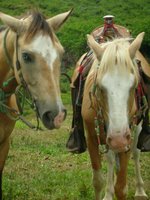
After we finished our tour, Jenn and I decided to extend our trip. We spent another day in Puerto Ayora. With the assistance of our new friend, Dario, we found a local hang out spot: Las Grietas, a hidden gorge with a large salt water pool for swimming. The next day we took a boat to the largest island in the Galapagos, Isabela. Besides visiting a couple of lagoons with flamingos and another giant tortoise breeding center (these are getting a little old now), we also took a horseback ride to visit Volcan Sierra Negra and did some kayaking at the Tintoreras.
Volcan Sierra Negra is the world´s second largest volcanic crater. It erupted last year so most of the bottom was a new black lava field, but around one edge there was still some lush green foilage. My horse was Macando, which I thought was fitting since I just finished reading A Hundred Years of Solitude. In that book, Macando is the name of the city that remains hidden from outside influences and death for several lifetimes only to later be exploited by gringos, enjoy a brief moment of prosperity, and, eventually, to be abandoned.
To get to the Tintoreras, we launched our kayaks off the longest beach in the Galapagos and kayaked past the fishing boats temporarily captained by sea lions and a rocky area where penguins hang out.
The Tintoreras is a shallow canal where about thirty or so large white-tipped sharks hang out to eat. We couldn´t swim in the canal, but we snorkeled near its entrance. There were still a lot of sharks in this area. It was pretty cool seeing such a large concentration of sharks in one area. That night we walked along the beach under the nearly full moon and enjoyed a couple of drinks at the beachside bar, Betos.
The next morning, we caught a breathtaking sunrise before catching the only boat back to Puerto Ayora. I missed my scubadiving appointment, so Jenn and I went to Turtle Bay to catch some rays and do some (more) snorkeling. While sunbathing under a tree, Jenn got shat on (twice) by the famous Darwin finches. The second time it was minutes after she had switched me places. =) That night we had a sub-par sushi dinner at the Red Mangrove before meeting friends at Cafe Limon.
On my last full day in the Galapagos, I went scubadiving at Masquera and Seymor Norte. Both were beautiful dives with loads of fish. I also saw a lot of moray eels, a garden eel, a school of spotted rays, and, from a distance, one hammerhead shark. In the afternoon, Jenn and I walked around town and watched the sunset from the Darwin Center beach. We headed down the Malecon to watch the even more impressive moonrise. We spent our last night, surprise, at Cafe Limon. It was a slow ending to what has been one of the most amazing trips of my life.
Photos of snorkeling with turtles, penguins, and the view from the summit of Bartolome
Photo of Rabida and Iguanas at Santiago
Photos of Charles Darwin Center and Hanging out in Santa Cruz
Photo of Flamingos at Punto Cormorant and dolphins on the way to Santa Cruz

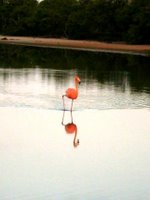
Day 4 we visited three places on or near Floreana: (1) Punta Cormorant, home of a bright-pink flamingo colony; (2) Post-Office Bay, a mailbox where passengers from each boat that stops picks up and delivers the letters addressed to people who live near the passenger (no stamp required); and (3) Devil´s Crown, the circular remains of a volcano and a great place for snorkeling.
Some bottlenosed dolphins joined us for a couple of miles on our way to Santa Cruz. We partied it up on the main island that evening at a Gringo Bar Cafe Limon.
Photo of blue-footed boobies and sunbathing with the sea lions at Gardner Bay
Photo of Snorkeling with the sea lions at Santa Fe


These are photos David took (my camera isn´t waterproof) of us snorkeling with the sea lions in Santa Fe. They seemed quite curious about these strange creatures that couldn't flip over and propel themselves quickly through the water. Several times I found myself face-to-face with one looking at me very inquisitively.
Photo of the Aida Maria and a crab on Bachas
Sunday, April 09, 2006
Day 68-80 Somewhere on the Galapagos Islands
Here are some of the highlights:
The first time we went snorkeling--I found myself swimming with a whole school of angel fish. I was floating along, taking in the moment, when the fish scattered. I looked over and there was a four- or five-foot white-tipped shark. Though I knew that it was harmless, I froze. It looked too much like a shark from Jaws. Before I had time to recover from my initial shock, a sea lion buzzed by on my rights side, then another on my left side, chasing the shark away. Suddenly I was surrounded by sea lions, who seemed to be just as curious about me as I was about them. One approached me and cocked his head to the side as if he were trying to figure out what was this strange creature. The others were flipping and twirling and basically teasing us about our limited swimming abilities.
Laying out on Espanola at Gardner Bay--There were so many sea lions and they would waddle up to where you were laying and just plop down beside you.
Animal watching--Every day we would walk on at least one new island. It never ceased to amaze me how unafraid the animals were. Birds, iguanas, sea lions, land turtles, lava lizards, you name it, they would walk right up to you.
The view from Bartolome--Bartolome was by far the most beautiful island we visited. Though it didn´t have as many animals as some of the other islands, from the summit you could see the lava field on Santiago, Sullivan Bay, and the other beach near Pinnacle Rock.
Cafe Limon--Though the music was horrible, every time we went there (only 3 times) we had a great time.
Snorkeling at Las Tintoreras on Isabela--After a long day riding horses to Volcano Sierra Negra (the world´s second largest volcanic crater) and sea kayaking, it was very refreshing to go snorkeling especially in a place with so many sharks. I swam past at least four very large white-tipped sharks.
Scubadiving at North Seymour--This was a great dive along a channel. I saw a LOT of moray eels, a garden eel, several spotted rays, and, from a great distance, a hammerhead shark.
The People--I made so many great friends on this trip. It made it that much harder to leave the island.
For the curious, here are the places we visited:
Day 1-Baltra and Bachas
Day 2-Islas Plazas and Santa Fe
Day 3-Española (Puerto Suarez and Gardner Bay-scubadiving!)
Day 4- Floreana (Punta Cormorant and Post Office Bay), the Devil´s Crown, and Santa Cruz (Puerto Ayora)
Day 5- Santa Cruz (Charles Darwin Center and Parte Alta)
Day 6 - Rabida and Santiago (Puerto Egas)
Day 7 - Bartolome (summit, pinnacle rock, Sullivan Bay)
Day 8 - North Seymour and Baltra (this is the part where I was supposed to return to Quito, but I changed my flight and spent an extra 5 days in the Islands). Return to Puerto Ayora, Santa Cruz and check out Las Grietas, a gorge with a salt water tide pool at the bottom.
Day 9 - Isabela (Laguna Flamenco and longest beach in Los Galapagos)
Day 10 - Isabela (horseback ride to Volcan Sierra Negra and Volcan Chico, sea kayaking to Las Tintoreras to see the shark canal, snorkeling near the shark canal)
Day 11- Santa Cruz (Turtle Bay)
Day 12 - Scubadiving at North Seymour and, after returning to Santa Cruz, the Charles Darwin center beach.
Day 13 - Goodbye Galapagos.
Friday, March 31, 2006
Day 63-66 - Guayaquil, Ecuador
There is some decent shopping here, but that is probably a bad idea given the dent the trip to the Galapagos is going to put on my credit card. I hate to admit it, but I do enjoy eating at familiar fast food establishments such as KFC and Dunkin Donuts. Also, I have been watching a lot of movies on cable. I feel like I´m wasting precious vacation time. This is the first time since I started the trip that I have had absolutely nothing to do.
BTW-I´m going to be in the Galapagos Islands for 8 days. I arranged the trip through the fabulous Detour Destinations. I will probably be incommincado for the near future.
Wednesday, March 29, 2006
Day 62 - Trujillo


The hostel´s website forecasts that the weather will be warm, dry, and sunny. Apparently that forecast is correct 305 days a year. This balmy climate was the perfect place to catch my breath.
I started the day at Chimu site of Chan Chan. We looked at just two of the nine temples that are scattered throughout the city. At first glance, the piles of sand and rubbish look more like a garbage dump than a famous archaeological site. My guide assured me that Peru had more important things to worry about than picking up litter as we swerved around the bus-sized pothole. The site was much more impressive, and clean, though, once we entered the site. The piles of sand were actually the partially deteriorated walls of the ancient temple. Although the history of the society itself was not as interesting to me as the Incans', it was neat to see walls that had been built out of mud bricks in 1300 A.D. still standing and some of the carvings still intact.
After a nap and great lunch of homemade ceviche (raw fish soaked in lime juice), I went to the Moche temples of the Sun and the Moon. These stepped pyramids pre-date the Chimu site and the carvings inside this temple still have some of their original colors. It was fascinating to see paint and mud that have survived centuries of rain, wind, graverobbers, and earthquakes.
Day 61 - Cusco - Lima - Trujillo
The flight finally left at noon. I got in Lima with enough time to catch a taxi for a whirlwind ride through Lima. I knew it was going to be a wild ride when the taxi driver put on his seat belt! That never happens! At the bus station, I had ten minutes before my bus left. Ten hours later, I arrived in Trujillo. It was 1 a.m.
Day 61 - The Ruins around Cusco

There are four Incan ruin sites that are within walking distance from Cusco¨Sacsayhuaman, Quengo, Pucapucara, and Tambo Machay. I took the bus instead.
Our guide was a curious man who insisted on using a whistle (¨two blows means we´re going and three blows means we´re here¨), and carrying Cusco´s flag, which, coincidentally, is identical to the gay pride flag.
I think I mentioned in an earlier entry that the Incans intended Cusco and the surrounding area to be shaped like a Puma. Sacsayhuaman (above), or, as the gringos call it, "sexy woman", was supposed to be the puma´s head. The zig-zag walls, which are made of precisely carved stones, make up the Puma´s teeth. I thought it was a sad irony that this Incan religious site is now also a home to a large Christ figure that overlooks Cusco.
Quengo was a little less impressive. It looked like a big pile of gigantic rocks. It is believed, however, that before the catholics destroyed it, it was a large statue of a puma or other sacred animal. At the top of the rock were also partially destroyed carvings of the Incans three sacred animals: condor, llama, and puma.
Pucapucara was also underwhelming. I guess I ´m a bit jaded. It was the first Incan bathroom I had seen yet though.
It was getting dark at our last stop, Tambo Machay, but I could still see that this ruin was much prettier than the previous two. It was a stepped, stone structure with a beautiful fountain running down two of the levels. Very peaceful!
Monday, March 27, 2006
Day 60 - MachuPicchu
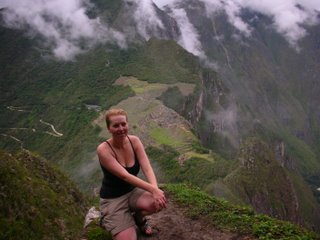

I didn´t get to hike the Inca Trail as I had originally planned. I cannot blame it all on my knee, though. I had decided to do the two-day hike despite my knee. Before getting to Cusco I checked to make sure that there were permits available for the day I needed to start the hike. There were plenty, but what I didn´t know is that there is a ridiculous three-day waiting period to obtain the permit. This was time that I didn´t have. This was the second major disappointment of my trip.
That being said, Machupicchu was absolutely amazing. From Ollanta, I took the backpacker´s train to Agua Calientes and stayed the night there. I got up at 4:30 to hike to the park and watch the sun rise. It was an incredible, steep hike, almost straight up the mountains. Although it was still dark outside when I started and there was only a crescent moon, it was still light enough to see my way up the stairs and to see the mist rising off the mountains.
When I finally got to the park, I was rewarded with spectacular, clear views of the ruins and a relatively people-free park. I wandered around the ruins for another couple of hours before begining the climb to WaynaPicchu, the tall mountain behind the ruins. It took about an hour-and-a-half to climb because I was helping a seventy-year-old Peruvian who was visiting the park for the first time. The views were well worth the steep ascent and gave us a bird´s eye view of the park. From here we could see that the park was now overrun with other tourists.
Kirsi, a german girl I met on the hike, and I decided to take a different trail down. Little did we know that the trail didn´t just take us to where we started, but also included a very steep descent to the Great Cave. After this two-hour detour, we were exhausted. We passed out on the lawn in front of the Sacred Rock. We shared my last mango.
That night I recovered by soaking my muscles in the hot, albeit commercialized, waters of the hotsprings that the town is named after.
Day 59 - Sacred Valley (Pisaq and Ollantaytambo)
Cusco is surrounded by some really amazing Incan ruins. On my way to MachuPicchu, I visited two of the sites located in Sacred Valley, Pisaq and Ollantatayambo. The structures are amazing and have weathered well.Pisaq is a terraced mountain with incredible views of the Rio Urubamba Valley. Ollanta is an Incan temple at the top of a mountain and was used as a fortress after the Spanish conquests. It has impressive walls made of gigantic stones that had to be both carried across a river and hauled up the side of the mountain.
The Incans were so advanced, I can´t help but wonder how different life would be today if they hadn´t been conquered by the Spaniards and degraded by the catholics. For example, the Incans knew how to create earthquake-proof buildings, move rivers, and move gigantic rocks for their temples. The precision with which they were able to measure distances is unbelievable (Cusco, Pisaq, and one other Incan site are exactly 33 km from each other forming a perfect triangle with huge mountains between them). Their calendar is so precise. I am really intriqued by the Incan culture and definitely plan on learning more.
Day 57-58 - Cusco, Peru

Cusco, the ombligo (belly button) of Incan Culture, is much bigger than I thought it would be. It reminds of Venice in that the best place to be in Cusco is lost. Around every corner is a beautiful church or Incan relic.
Other than walking from my hostel to the Plaza de Armas ten plus times a day, I have been catching up on the mundane; updating email, doing laundry, pigging out on Mexican food (I haven´t had it for almost two months now), and arranging my trip to MachuPicchu. The nightlife here, although completely gringoed out, is fantastic. Promoters will do anything to get you into their clubs--free passes, free drinks. I even witnessed promoters from two different clubs having a tug-o-war over a customer.
It just so happened that three different groups of friends that I had met in other parts of the world--two girls from Germany that I met on the Uyuni trip and in La Paz, a couple from Canada that I met Iguazu, and some Argentinians--were all in Cusco at the same time. I spent my last night here hopping from bar to bar to spend time with each group. It was a very late night!
Thursday, March 23, 2006
Day 53-56 - Lago Titicaca (Bolivia and Peru)



Lago Titicaca (Rock of the Puma Lake) is the world´s highest navigable lake. After a day exploring Copacobana (the one that doesn´t have a song about it) on the Bolivian shore of Lago Titicaca, Regina and I headed for an overnighter on Isla del Sol. Isla del Sol is considered the birthplace of Incan culture and is named Island of the Sun because the Incans believe that it is the birthplace of the sun. It is not hard to imagine why when you see the sunrise. The sun looks as if it is rising directly out of the water in the middle of the lake.
After watching the sunrise, we headed back to the mainland to catch a bus to Puno, Peru. This border crossing did not involve nearly as much culture shock as the last one. Peru, thus far, seems very similar to Bolivia.
From Puno, we visited the Isla Flotantes, a series of man-made floating islands. The island is formed by weaving layers of reeds on top of each other. These islands have been around since 1000 A.D. As one layer begins to deteriorate, the residents add another layer. The islands are held in place by poles, which are removed during the rainy season so that the inhabitants can row the island to a more shallow part of the lake. I have never seen anything like it! The ground, huts, roofs, and knick-knacks are all made of these reeds. Our guide told us that the people even eat part of the reeds for breakfast. I tried some . . . kinda tasteless.
Monday, March 20, 2006
Day 51 - Somewhere in the Amazon Basin (Day 3)


As if we weren´t afraid enough of running into one of the two other alligators, during our last night in the Pampas, yet another alligator decided our camp was the happening place to be.
It was another early morning. We went to watch the sunrise over the Pampas. It was beautiful. The sun was a coral orange color. For the rest of the day, we went to feed more monkeys, swam with more dolphins, and went fishing for pirana. I actually caught a pirana too!
Day 50 - Somewhere in the Amazon Basin (Day 2)

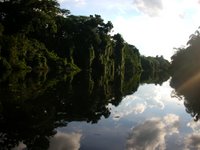
It was a good thing that we went to bed early last night because we were scared out of bed pre-dawn by terrifying roars and a series of loud crashing sounds. I tried going back to sleep and was dreaming that we were going to war when someone said that the sound was howler monkeys. When we got outside of the cabin, we realized the crashing was the sound of them throwing pods off of the trees and monkey poo at our cabin.
After breakfast, we put on long pants, long shirts, and knee-high boots to go Anaconda hunting. Unfortunately, the knee-high boots did little to protect us from the waist-deep water. After tromping through the mud and water for an hour, we walked around an island looking to see if there were any anacandas sunning on the tree branches. Still no luck. After another hour tromping through mud and weeds, we headed back to the boat.
I was a little disappointed, but more relieved. . . well at least until I stepped on an anaconda in the water. I screamed like only a girl can. By the time my guide realized what was going on the snake has slithered away. When I was obviously shaken, the guide´s assistant, Doya, asked me, ¨Didn´t you want to see an anaconda?¨ A legitimate question during an anaconda-hunting expedition. My response was, ¨Yeah, I wanted to see an anaconda. I wanted the guide to see an anaconda and point it out to me so I could take a picture and say I´ve seen an anaconda. I didn´t want to step on an anaconda.¨
When we got back from the hunting trip, we realized that yet another alligator had decided to camp with us and that his favorite spot for sunning was directly beneath the walkway that leads to our cabin door.
After lunch, we put on our swimsuits and went searching for good swimming spots. It wasn´t the first time on the trip that we had seen the pink river dolphins, but it was the first time that we were permitted to swim with them. I know it sounds like something straight out of a science fiction novel, but the dolphins really are pink. Not a crayola pink, but more of a salmon pink.
It was really great swimming with them. At first the dolphins were shy and kept their distance. But while the group was being loud and distracted showing off for each other, Regina and I swam away from them. Suddenly there were dolphins surfacing all around us. We exchanged smiles, knowing that we had the dolphins to ourselves.




